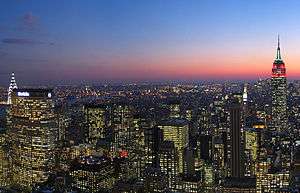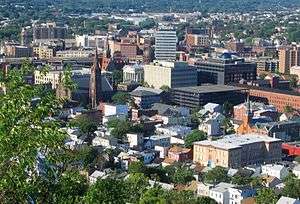Peruvian Americans
 | |
| Total population | |
|---|---|
|
(626,789[1] 0.19% of the U.S. population (2014)[1]) | |
| Regions with significant populations | |
| Languages | |
| Religion | |


Peruvian Americans (Spanish: peruano-americanos, norteamericanos de origen peruano or estadounidenses de origen peruano) are Americans of Peruvian descent. Among Peruvian Americans there are those of White (mostly Spanish), mestizo, Amerindian, and Afro-Peruvian descent, as well as others, including British, Italian, French, German, and Arab, or a mix of any of these. A significant number are of pure or mixed Chinese and/or Japanese heritage.
Peruvians have emigrated mainly due to political turmoil and economic hardships the country had faced during the 1980s. Peruvian Americans are a relatively recent ethnic group, as most of them have moved to the United States since 1990. According to the U.S. Census Bureau, 594,418 U.S. residents identify themselves as being of Peruvian origin.[5]
History
Small but significant waves of immigration occurred in San Francisco during the gold rush (along with Chilean miners beginning in 1848) and the Metro Detroit area in the 1950s. However, the majority of Peruvians that have emigrated to the United States have arrived since the 90s. Peruvians typically emigrate due to economic reasons, to escape poverty and pursue a better quality of life. Significant demographics of Peruvians are found in Northern New Jersey,[6][7] the New York City Metropolitan Area, Miami, the Washington, D.C. Metropolitan Area, and Los Angeles.
Culture
The most famous and first aspect of Peruvian culture that deals with the United States is the book, "The Incas's Florida" La Florida del Inca written at the end of sixteenth century by the Inca Garcilaso de la Vega. Garcilaso's book details the travels of the explorer Hernando de Soto who had participated in the Forty-Years War between the Incas and the Spanish (1531–1571) and who later came to the lands that would become the United States and that the Spanish called "Florida."
The most popular dishes of Peruvian food in the U.S. include cebiche (raw fish "cooked" in lime juice), papa a la huancaina, and anticuchos y tamales. Peruvian cuisine is often recognized for being one of the most diverse and appreciated of the world's cuisines, with influences including European, Native American, and African. Since there is a sizable Chinese and Japanese minority in Peru, an Asian influence has also been deeply incorporated in Peruvian cuisine. There are Chifas, or Asian style Peruvian restaurants that serve typical Chinese or Japanese food with a Peruvian culinary influence. Inca Kola, a soda that originated in Peru, is sold in many heavily concentrated Latino areas.
Socioeconomic status
Despite being a relatively recent ethnic group, the median household income for Peruvians meets the average American household income and 30% of all Peruvians over the age of 25 have college degrees,[8] exceeding the US national average of 24%.
Activism
The Peruvian American Coalition in Passaic, New Jersey[9] functions as an activist organization on behalf of the overall welfare of Peruvian Americans.
Demographics
Peruvians have settled throughout the United States, migrating particularly to Northern New Jersey and the New York City Metropolitan Area, the Miami metropolitan area, the Washington Metropolitan Area, and the Los Angeles metropolitan area.[10]
Notably, a rapidly growing number of Peruvian Americans have established an increasingly prominent community in Paterson, New Jersey,[6] which is considered by many to be the capital of the Peruvian Diaspora in the United States,[3] partially owing to the presence of the Peruvian Consulate. Market Street, the Little Lima in downtown Paterson, is the largest Peruvian American enclave and is lined with Peruvian-owned restaurants, bakeries, delicatessens, bodegas, travel agencies, and other businesses. The Peruvian American community has expanded into Paterson's neighboring areas of Fair Lawn, Elmwood Park, Clifton, and Passaic in Northern New Jersey as well, all within the New York City Metropolitan Area. The annual Peruvian Independence Day Parade is held in Paterson.[4][11]
States with highest Peruvian population
The 10 states with the largest Peruvian population were (Source: Census 2010[12]):
- Florida - 100,965 (0.5% of state population)
- California - 91,511 (0.2% of state population)
- New Jersey - 75,869 (0.9% of state population)
- New York - 66,318 (0.3% of state population)
- Virginia - 29,096 (0.4% of state population)
- Texas - 22,605 (0.1% of state population)
- Maryland - 18,229 (0.3% of state population)
- Connecticut - 16,424 (0.5% of state population)
- Georgia - 10,570 (0.1% of state population)
- Illinois - 10,213 (0.2% of state population)
The U.S. state with the smallest Peruvian population (as of 2010) was North Dakota with 78 Peruvians (less than 0.1% of state population).
Percentage rankings
The top 25 US communities with the highest percentage of people claiming Peruvian ancestry are:[13]
- East Newark, New Jersey 10.1%
- Harrison, New Jersey 7.01%
- Paterson, New Jersey 4.72%
- Kearny, New Jersey 3.82%
- The Hammocks, Florida 3.36%
- Port Chester, New York 3.30%
- Virginia Gardens, Florida 3.24%
- Prospect Park, New Jersey 3.22
- Bay Harbor Islands, Florida 3.11%
- Doral, Florida 2.95%
- Haledon, New Jersey 2.71%
- Garfield, New Jersey 2.55%
- Union City, New Jersey 2.53%
- Both Key Biscayne, Florida and Glen Cove, New York 2.48%
- Passaic, New Jersey 2.42%
- White Plains, New York 2.39%
- Elizabeth, New Jersey 2.35%
- Rye, New York 2.33%
- Ojus, Florida 2.29%
- Clifton, New Jersey 2.27%
- Elmsford, New York 2.25%
- Perth Amboy, New Jersey 2.20%
- North Bay Village, Florida 2.17%
- Kendale Lakes, Florida 2.03%
- Kendall, Florida and the borough of Carteret, New Jersey 2.01%
Notable Peruvian Americans
- Daniel Alarcón - Peruvian born, American raised author
- Carlos Yushimito del Valle - Peruvian writer.
- Daniella Alonso - American actress. Her mother is Puerto Rican, and her father is from Peru, of Japanese origins.
- Marie Arana - editor, journalist and Peruvian born author
- Miguel Arteta - Puerto Rican director of film and television, known for his independent film Chuck & Buck (2000), for which he received the Independent Spirit John Cassavetes Award, and Cedar Rapids. He is of Peruvian father and Spanish mother,[14]
- Anthony Atala- M.D., is the W.H. Boyce Professor and Director of the Wake Forest Institute for Regenerative Medicine, and Chair of the Department of Urology at the Wake Forest University School of Medicine in North Carolina. He is a Peruvian born, but American raised.[15]
- Juan Bandini - (1800 – 1859) was an early settler of what would become San Diego, California
- Mandalit del Barco - general assignment reporter for National Public Radio
- Amber Barretto - American actress
- David Bernal - illusionary dancer
- Benjamin Bratt - actor, Peruvian on his mother's side
- Pepe Barreto - community and entertainment reporter for KMEX-TV, Channel 34
- Miguel Harth-Bedoya - Peruvian conductor
- Jorge Benitez - (also known as George Benitez) is a former U.S. soccer forward
- Lorenzo O'Brien - writer-producer
- Carlos Bustamante biologist
- Julio C. Canani - Peruvian trainer in American Thoroughbred horse racing who has won three Breeders' Cup races.
- Roberto Carcelen - Peruvian-American cross-country skier
- Carmen Carrera - American model of Peruvian and Puerto Rican descent
- Carlos Castaneda - philosopher
- Diego Chávarri - footballer
- Arthur Chin – America's first flying ace in World War II
- Roberto Eyzaguirre - classical pianist and famed piano pedagogue.
- Kenny Florian - mixed martial artist
- Gabriela Lena Frank - American pianist and composer of contemporary classical music.
- Robert Garcia - politician
- Richard Green - football (soccer) defender
- Kathleen Herles - American voice actress
- Josh Keaton - actor, singer and musical producer
- Q'orianka Kilcher - actress
- Alex Kuczynski - journalist
- Isabela Moner - actress, voice actress, singer, songwriter, dancer and ukulele player
- Adele Morales - American painter and memoirist. He is of Spanish and Peruvian descent.
- Carlos I. Noriega - astronaut
- Alex Olmedo - former tennis player from Peru with American citizenship[16]
- Luis Palomino - Peruvian American mixed martial artist who competes in the lightweight division
- Edgar Prado - Jockey
- Plavka - American singer of Croatian and Peruvian origin
- Tina Peña - Host of "Temas en Tulsa"
- Kat Reeder - artist, illustrator and graphic designer
- Ginger Reyes - rock musician
- Alex Rivera - US film maker specialising in films about labor, immigration, and politics
- Jose A. Santillan - Peruvian- American Actor and Currency Trader. Also has many doubles in the DC metro area.
- Wenceslaus Sarmiento - also known as W.A. Sarmiento, Peruvian-born American modernist architect.
- Carmen Giménez Smith - American poet, writer, and editor.
- Tony Succar - Peruvian born American musician, composer, arranger and producer.
- Yma Sumac - indigenous soprano
- Immortal Technique - Felipe Coronel is a political rapper based in New York
- Thes One - rapper
- Mario Testino photographer
- Daniel Tuccio - Peruvian-American television reporter/news anchor.
- David Utrilla - The 31st member of the Utah Corps of Consuls
- Jose Valdivia, Jr. - jockey in American Thoroughbred horse racing.
- Carlos De Valdez (1894–1939) - Peruvian film actor who appeared in around forty American films. He spend the last years of his life in United States (where died).[17]
- Boris Vallejo - Peruvian-born American painter.
- Alberto Vargas - Peruvian painter of pin-up girls.
- Ian Vásquez - director of the Cato Institute's Center for Global Liberty and Prosperity
- Barton Zwiebach - physicist working on String Theory
- Denise Schaefer - Peruvian-born model
See Also
- United States American Peruvians
References
- 1 2 US Census Bureau 2014 American Community Survey B03001 1-Year Estimates HISPANIC OR LATINO ORIGIN BY SPECIFIC ORIGIN retrieved October 18, 2015
- ↑ "Yearbook of Immigration Statistics: 2011 Supplemental Table 2". U.S. Department of Homeland Security. Retrieved 2012-07-08.
- 1 2 "A Brief History of Peruvian Immigration to the United States". yumimmigrantcity.com. Retrieved 2013-04-03.
- 1 2 "Photos: Annual Peruvian Day Parade in Passaic County. The parade makes it way down Market Street in Paterson". North Jersey Media Group. 2014-07-27. Retrieved 2014-07-27.
- ↑ "Hispanic or Latino by Specific Origin" United States Census Bureau
- 1 2 Karen Sudol (2013-07-27). "North Jersey Peruvians celebrate Peru's independence with a flag raising in Paterson". North Jersey Media Group. Retrieved 2013-07-28.
- ↑ Linda Moss (2013-07-28). "Tens of thousands line the route for Passaic County's annual Peruvian parade". North Jersey Media Group. Retrieved 2013-07-29.
- ↑ http://factfinder2.census.gov/faces/tableservices/jsf/pages/productview.xhtml?pid=ACS_10_1YR_S0201&prodType=table
- ↑ Lindy Washburn (2014-08-25). "A new playbook for hospitals: How investors pursue a financial turnaround". North Jersey Media Group. Retrieved 2014-08-26.
- ↑ "Yearbook of Immigration Statistics: 2010 Supplemental Table 2". U.S. Department of Homeland Security. Retrieved 2011-04-11.
- ↑ "Photos: Parade celebrates Peruvian heritage". North Jersey Media Group. 2015-07-26. Retrieved 2015-07-26.
- ↑ http://factfinder2.census.gov/faces/tableservices/jsf/pages/productview.xhtml?pid=DEC_10_113_QTP10&prodType=table American FactFinder - QT-P10: Hispanic or Latino by Type: 2010
- ↑ "Ancestry Map of Peruvian Communities". Epodunk.com. Retrieved 2008-01-26.
- ↑ "Miguel Arteta:Overview". MSN. Retrieved April 24, 2011.
- ↑ "Scientist at Work: Anthony Atala".
- ↑ "While Critics Cry, He Wins", Lakeland Ledger, August 23, 1959, page 19.
- ↑ Pitts, Michael R. Western Movies: A Guide to 5,105 Feature Films. McFarland, 2012.
External links
- http://www.peruanosenusa.net
- http://www.peruvian-americans.tv
- http://www.peruvianamericans.com
- http://www.peruvianamerican.com
- http://www.curito.com
